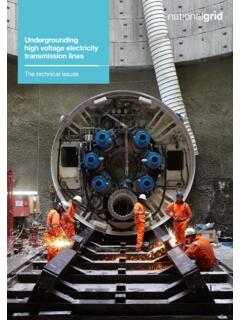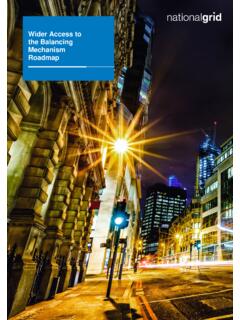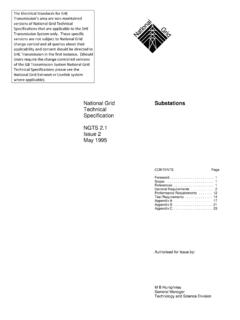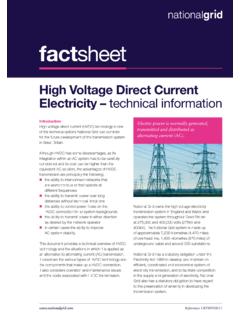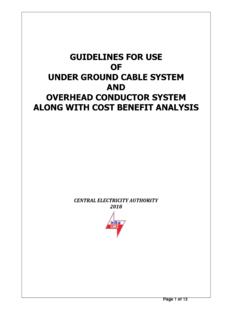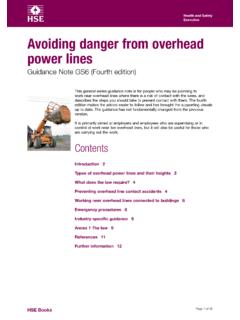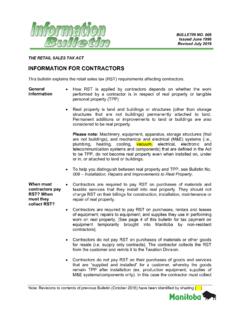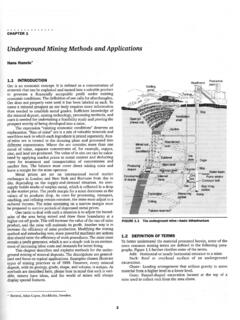Transcription of for development near high voltage overhead lines
1 Design guidelinesfor developmentnear high voltageoverhead linesNational Grid Company plc owns, operates andmaintains the high- voltage electricity transmissionnetwork in England and Wales. It is part of NationalGrid Transco plc, an international energy deliverybusiness and the UK s largest investor-owned utilitycompany. National Grid Transco also owns andoperates Britain s natural gas transportation systemand electricity and gas businesses in the northeastern of support4 Introduction5 Who is this guidance for?6 The need for design guidelinesThe need for design guidelines11 development and overhead power lines :National Grid s role and responsibilities12 The context for these guidelines13 Acknowledging the wider debate16 Understanding the characteristics of power linesUnderstanding the characteristics of overhead power lines 21 Design implications of overhead power lines22 The components of overhead power lines23 Safety clearances and maintenance requirements27 Creating a sense of place.
2 Design guidelinesApproaches to site layout and design33 Prioritising the public realm34 development density35 Orientation of streets and blocks36 Topography39 Breaking down linearity40 Utilising land close to overhead power lines42 Screening by landscape design45 Promoting richness48 How to use this guidanceHow to use this guidance53 Putting it all together54 Help for developers and landowners61 Application by local authorities62 Community involvement63 Future steps64 Appendices1. Research and study method692. Case studies703. Planting near high voltage overhead lines824. Active recreation845. Relocating overhead power lines866. Undergrounding887. Tower design908. Noise919. Safety clearances9210. Electromagnetic compatibility9411. Electric and magnetic fields9512. Glossary9613. Bibliography10114. Contributors10215. Contacting National of supportStatement of supportAs organisations committed to best practice in urban design, regeneration and land use planning, weare pleased to offer our support for the Sense of Place initiative.
3 We believe that these guidelines willbe of value to many groups and individuals involved in the design and development process, offeringinnovative and practical guidance on the development of land near high voltage overhead lines . A consequence of current policy is that significant urbanisation is being planned on the edges oftowns where a common constraint is overhead power lines which typically converge to serveconcentrations of urban situations where overhead lines cannot be diverted away from development and/ or placedunderground, they should be accepted as an unavoidable feature of the landscape the impact ofwhich is to be mitigated by skilled urban TCPA is pleased to endorse the urban design guidance prepared by National Grid forsituations where overhead power lines may have to remain. 4 London Sense of Place Design Guidelines have been developed by National Grid in partnership withDavid Lock Associates to address the issues associated with developing sites crossed by, or in thevicinity of, pylons and high voltage overhead specifically relate to the existing high voltage overhead lines (275kV and 400kV) operated byNational Grid, but could in certain circumstances also apply to lower voltage overhead lines on steelpylons (132kV and below) operated by the local distribution do we need this guidance?
4 This work has been carried out in recognition of the increasing pressure for the sustainabledevelopment of land. A renewed focus on previously developed land is leading to the redevelopment offormer industrial areas and the regeneration of our towns and cities. The sustainable urban extension ofexisting settlements is promoting a compact urban form that minimises the need to travel. Many ofthese potential development sites are crossed by overhead lines , some of which are high voltageoverhead Grid sometimes receives requests to move overhead lines , or put them underground , whendevelopment is proposed nearby. National Grid s approach is to seek to retain its assets in situ, thoughit recognises that there may be exceptional circumstances that would justify the request where, forexample, the proposal is of regional or national importance. Leaving aside the cost and technicalcomplexity of moving or undergrounding existing overhead lines , the National Grid network is afundamental and permanent part of our national infrastructure and should be treated as , National Grid recognises that the presence of high voltage overhead lines across a sitepresents a constraint on development .
5 These guidelines look to promote the successful development ofsites crossed by existing overhead lines and the creation of well-designed places. The guidelinesdemonstrate that a creative design approach can minimise the impact of overhead lines whilstpromoting a quality for residential and commercial developmentThe guidelines primarily address issues relating to residential development , as this is clearly one of themore sensitive forms of development in close proximity to overhead power lines . However, the designprinciples equally apply to other forms of guidelines also set out some of the technical issues faced by developers of such sites. Theappendices contain useful information on possible technical considerations, including noise,interference, electric and magnetic fields (EMFs) and the operational and maintenance requirements ofNational in consultation with the development industryThe guidelines have been produced in consultation with a wide range of interest groups, organisationsand individuals from the development industry.
6 It is with thanks to the participation of theseorganisations and their most valuable comments that the guidelines have reached this final work and further information is available on the Sense of Place website on the guidelines is welcome. If you have any queries or comments on this work, pleasecontact National is this guidance for ?Who is this guidance for?Maintaining and enhancing the quality of the built and natural environment is increasingly importantto all of aim of this design guidance is to meet these aspirations by promoting the highest possible qualityin the design of development on land crossed by existing high voltage overhead lines and to suggestways in which the environmental impact of high voltage overhead lines can be guidelines provide a practical tool-kit of design principles for all parties: Developers, landowners and designers:These guidelines will help provide greater clarity about thedesign constraints posed by high voltage overhead lines , along with greater awareness of theopportunities, through good design, to improve the environment and therefore the value ofdevelopment.
7 Local authorities:The guidelines will promote awareness of the potential to develop and improvethe environmental quality of land close to high voltage overhead lines , and provide a suggestedpolicy and supplementary planning guidance on the development of land crossed by high voltageoverhead lines . Communities:The guidelines provide a useful additional resource for communities taking part inplanning events in setting out the potential for the successful development of land close to highvoltage overhead careful design, a high quality environment is possible near high voltage overhead needfor design guidelinesThe need for design guidelines11 development and overhead power lines :National Grid s role and responsibilities12 The context for these guidelines13 Acknowledging the wider need for design guidelinesThe need for design guidelinesNational Grid is the electricity transmission business in England and Wales. The electricitytransmission system consists of over 7,000 route kilometres of high voltage overhead lines .
8 Historically,where development took place close to these high voltage overhead lines , little attention was paid tothe design and layout of development and its relationship to the electricity equipment. The result hasbeen the creation of what we might now consider poor environments and we know we can do increasing pressure for development and the urban renaissance planning agenda are leading tomore development sites being brought forward through the planning process on land that is crossed byNational Grid equipment. A snapshot of development plans in England and Wales showed that 48 sitescrossed by National Grid overhead lines are currently allocated for built development , and this figure islikely to high standards of design and sustainable development forms advocated by the emerging planningand urban design agenda require a more creative approach to new development around high voltageoverhead lines : the need for guidance is of National Grid electricity transmission and overhead power linesDevelopment and overhead power lines :National Grid s role and responsibilitiesNational Grid provides the transmission of electricity from the point of generation across the countryto the major centres of demand, which are the main urban areas where most people live and useelectricity.
9 The National Grid system is integrated throughout England and Wales and has links toScotland, the Isle of Man and France. For the most part the system crosses rural areas and skirts themajor urban conurbations. It also feeds directly into the industrial areas of the country where heavyindustry has high electricity demands. The National Grid system is a fundamental part of our of the National Grid system was developed in the 1950s and 60s, when the main concern was tobring electricity to the centres of demand. Since that time we have all become used to the benefitsbrought by electricity whilst at the same time becoming increasingly aware of our environment. Issuesto do with environmental quality, health and safety and social responsibility are now activelyconsidered and incorporated into all parts of National Grid s National Grid owns the land occupied by its substations, only exceptionally does it own theland which is crossed by its electricity lines .
10 National Grid cannot therefore prevent development closeto or under overhead lines , providing statutory safety clearances are maintained. National Grid doesnot benefit financially from the development of this land, but does have responsibility for theequipment and for maintaining the safe supply of electricity as required by statute under NationalGrid s licence to Grid is not a statutory consultee in the planning application process. Where high voltageoverhead lines are present on a site, it is recommended that National Grid is consulted at the earliestpossible opportunity in order that advice and guidance on development near high voltage overheadlines may be taken into guidelines therefore set out National Grid s commitment to the highest standards of design innew development around or near high voltage overhead lines , and promote creative design solutionsthat are compatible with its statutory duty to maintain the national electricity Grid is committed topromoting environmental quality,health and safety and context for these guidelinesThe context for these guidelinesRecent Government policy statements on creating well designed environments and an emphasis on thequality of the public realm, together with the broader professional and public debate about urbandesign and regeneration issues, all help to create a clear context for these guidelines.

